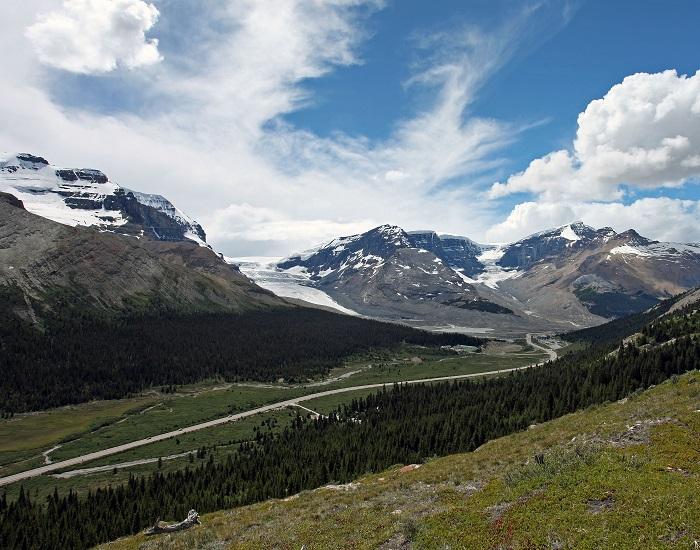
The Columbia Icefield is one of the many highlights along the Icefields Parkway in the Canadian Rockies/Scott Johnson
Trip to the Canadian Rockies
- Part 1: Jasper National Park
- Part 2: The Icefields Parkway
- Part 3: Yoho National Park
- Part 4: Banff National Park
There are trips where the road is the destination. In America, there’s Route 66, the Blue Ridge Parkway, Skyline Drive in Shenandoah National Park, and Going-to-the-Sun Road in Glacier National Park. After my wife and I explored the northern nexus of Jasper National Park, the world-famous Icefields Parkway beckoned.
The road, officially known as Highway 93, links Jasper to Banff National Park and connects two major east-west highways, the Trans-Canada (Highway 1) at the south and Yellowhead (Highway 16) to the north. But those are merely the details. A more apt description came from an early explorer, who dubbed the route “The Wonder Trail.” The scenic parkway opened in 1940 and snakes for 145 miles from valley to valley, with big rivers and bigger, snow-capped mountains a constant companion. Although most locations are named after the area’s trail blazers, a few are more descriptive of the “wonder” to be had.
The Endless Chain Ridge is not endless, though the near-uniformly sloped peaks line the highway for more than 12 miles, but the term can be applied to the entire drive. The mountains appear to go on forever. The Weeping Wall is a mass of limestone that rises straight up for more than 300 feet, and, as the name suggests, multiple waterfalls cascade from the top. In the winter, adventurers climb the frozen-over falls to the top. And there’s 11,339-foot-tall Snow Dome, at the heart of the Columbia Icefield, named for the thick mat of snow that lines its broad summit. Water from this peak flows to three oceans – the Arctic, the Pacific, and the Atlantic – and Dome Glacier spills over its shoulder. As a bonus, the route teems with wildlife. Bears, mountain goats, bighorn sheep, and deer can be seen along with an assortment of birds and critters.
Although you could traverse the parkway in a few hours, set aside at least a full day if traveling from Jasper townsite to Lake Louise, as you’ll probably want to stop at every opportunity. There are many attractions (far too many for us to see during our single day), and with plenty of hotels, hostels, and campgrounds along the way, you could easily fill multiple days along the parkway. Note that not all pullouts and attractions mentioned in brochures will be marked along the highway. For instance, there was no sign for the Goats and Glaciers viewpoint, and photogenic Peyto Lake can be seen from Bow Summit, though no signs single out Peyto. Another potentially challenging factor is that there are no mileage (or in this case, kilometer) markers along the road. So it’s helpful to have a navigator watching for landmarks if you’re looking for a specific location. (You also might want a co-pilot to keep the driver from drifting while being distracted by the scenery.)
Waterfalls, Thunderous and Graceful
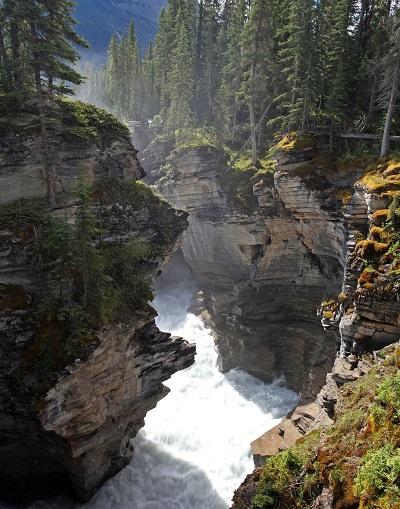
The Athabasca River churns through the jagged canyon it carved out/Scott Johnson
Our morning started at Wabasso Campground on the Athabasca Parkway, a 15-mile offshoot of the Icefields Parkway that follows the original route, on the west side of the Athabasca River. (The primary road was moved to the east side of the river in the late-1950s.) When taking in the sights around Jasper the previous day, I had expected to see more snow in the mountains in early July. Turns out, there were record-high temperatures in May, and alpine trails opened earlier than normal this year. Despite the seemingly small snowpack, the rivers in Jasper were not cheated. Each one seemed to roar with a purpose, moving swiftly and discouraging getting too close. The biggest of these is the Athabasca River, and children and pets should be closely monitored if walking the pathway at Wabasso.
A few miles south of the campground, where the Athabasca and Icefields parkways meet, the power of the river is on full display at Athabasca Falls. Here, the river squeezes as if sand in an hourglass, blasts through a colorful, grooved limestone canyon, then releases to a relatively calm outlet where the water widens again on its journey to the Arctic. There’s such an abundance of water that the only indication that the river drops 75 feet is the depth of the canyon walls just below the falls. Mount Kerkeslin watches over the falls from the east and makes for a nice photo opportunity if you beat the crowds. Somehow, a small island of rock has persisted amidst the churn of the water at its breach.
This is a busy spot, and a tour bus beat us there, so the main viewing platform was stuffed with a mass of people. Fortunately, an interpretive trail crosses the river and then leads both upstream and down. There were many viewpoints of the falls, so close that the park warns visitors to stay behind the rails to avoid slipping to a certain death. Just as interesting were the trails below the falls. We saw the rocky curves and creases created by the force of the river. We walked through a narrow, dry canyon for a close-up look of rock erosion caused by a previous channel of the river. An overlook allowed a grand view downstream, where a party of boaters was preparing to put in.
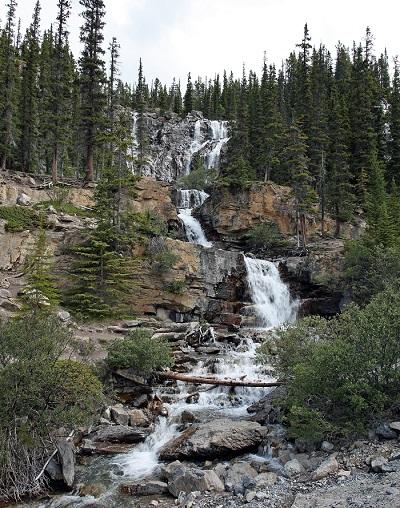
Tangle Falls is a popular stop near the Columbia Icefield/Scott Johnson
We returned to our car and turned onto the Icefields Parkway, stopping at three pullouts to admire the river and the impressive mountains. After 15 miles, we took a short turnoff to Sunwapta Falls. Here, there is a resort with accommodations, food, and gas. There’s also a short walk to another waterfall that’s similar to Athabasca Falls, only slightly smaller and less impressive (there’s even a rocky spire that rises from the spray and foam). As neat as the waterfall is, a view downstream of where the river crashes into a rock wall and changes course captured my attention. Over time, a cavity has formed, and the water churns beneath. At the falls, the trail allows for exploration, and many people got too close to the edge for my comfort. A family of four on the other side of the river took photos on a slippery rock perch with their backs turned above the rushing water. The river’s roar would have drowned out any attempt to yell at them, so we decided it was best to leave before witnessing a tragedy.
After 25 miles, an overlook of impressive Stutfield Glacier, rising above crisscross braids of the Sunwapta River and a hill so saturated with trees that I’m not sure another could be stuffed in, offered an appetizer for the Columbia Icefield.
A mile further, Tangle Falls is the opposite of Athabasca and Sunwapta. It gracefully drops about 150 feet over a handful of tiers before flowing under the road and meeting up with the Sunwapta. The creek wasn’t even a boot deep, so it was less imposing and more inviting. Being so close to the Columbia Icefield and the highway itself, this is another popular stop serviced by a couple of parking lots across the road. Visibility is low for drivers (some of whom don’t slow down), so be careful when crossing.
On a sunny day, this is a perfect place to get out and splash around or have a picnic. I decided to hike up to the top tier, where the creek split into three separate drops over the wall. The flow was apparently not at its peak, as I’ve seen photos with five or more drops. People were hanging out at every level, though, and they were all smiles. We ate lunch at our car and forged ahead to the main attraction.
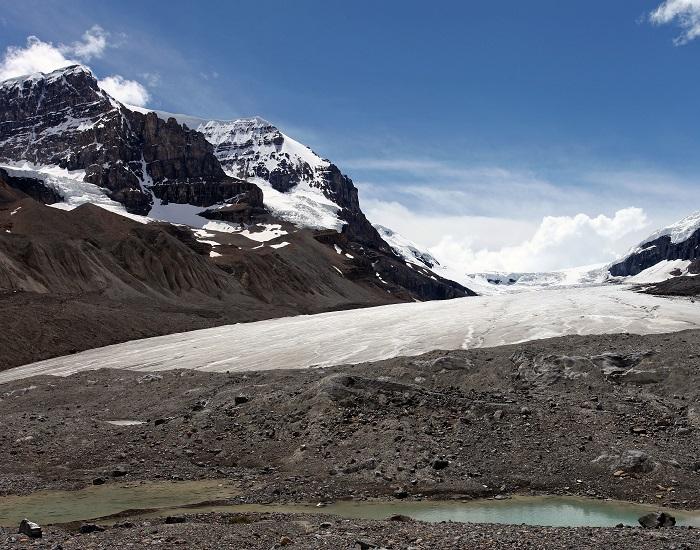
A short hike at the Columbia Icefield leads to the toe of Athabasca Glacier/Scott Johnson
The Columbia Icefield
At the heart of the Icefields Parkway is the Columbia Icefield, the largest such feature in the Canadian Rockies. An icefield is a body of ice from which glaciers flow in multiple directions, and eight named glaciers branch out from the Columbia. This area also contains many of the highest peaks in Jasper. The Columbia Icefield Glacier Discovery Centre sits next door to the icefield and near the midway point of the parkway, making it a convenient location to get out and stretch your legs. And in the summer, two full parking lots – one for cars, one for tour buses – may mean a long walk just to get to the building.
I was looking forward to our stop at the Discovery Centre, hoping to learn much about the Icefield and the region’s history and geology. My first impression, from the patio, had the “wonder” factor, with expansive views of numerous peaks and Athabasca Glacier, the most-visited glacier in North America, just across the road. Inside, however, the views were disappointing, unless you like lines. Lines to buy tickets. Lines to get food. Lines to use the bathroom. Turns out, the Discovery Centre is a glorified service station.
The main floor has a Parks Canada information desk, ticket booths for various tours, loading areas for the tours, and a gift shop. On the second level, the line for the cafeteria stretched the length of the building. And the top floor houses a boutique hotel. Not exactly what I was expecting. The closest thing to a museum was on the bottom floor, which had a couple dozen historic photos and a small theater showing a short film (which I was told isn’t very interesting). The good thing, though? It was the only place in the building where I wasn’t shoulder to shoulder with someone else. It was peaceful but not informative. Almost anything that I would consider “interpretive” required buying a ticket.
There are two major destinations for the tours offered at the Icefield. One heads back north on a bus to the Glacier Skywalk, which opened in 2014 at a cost of $21 million CA. This glass-floored observation platform, similar to the Grand Canyon Skywalk, juts out 100 feet from the side of a cliff, with views 918 feet above the Sunwapta Valley. Certainly you’ll come away with a cool story and fantastic photos, but this simply wasn’t worth the wait or hassle for us, particularly when confronted with the long lines. Of course, what used to be a free, public pullout along the highway now costs at least $32 CAD to visit, and I imagine that the scenes from many other pullouts along the road, like the one at Stutfield Glacier, offer similar vistas (though without the audio tour).
The second tour takes visitors onto Athabasca Glacier, across the parkway from the Discovery Centre, first by “snocoach” and then to get out for a short walk. We also passed on this to instead make a short hike to the toe of Athabasca Glacier. The small lot was full, and cars lined the gravel road on both sides. According to Parks Canada, the Athabasca Glacier has been receding or melting for the past 125 years, and in that time has lost more than half of its volume. We pulled over near a sign that noted where the glacier reached in 1942, and the glacier was a good half-mile in the distance.
Once we reached the parking lot and trailhead, a mile-long out-and-back passes a brown-colored meltwater lake before rising up a rocky moraine. Another sign about halfway up marked the 1982 terminus. The glacier fills the valley between two peaks, flowing over a ridge on the horizon for nearly four miles, close to where we were standing. Wind chilled by the ice prompted people to put on coats and hats, even on this mostly sunny summer day. A rope keeps people from getting too close, and those that have ventured beyond have fallen into cravasses to their deaths within viewing distance of the trail. More than a stop at the Discovery Centre, this short walk put in perspective the power of glaciers and how they shape the surrounding land.
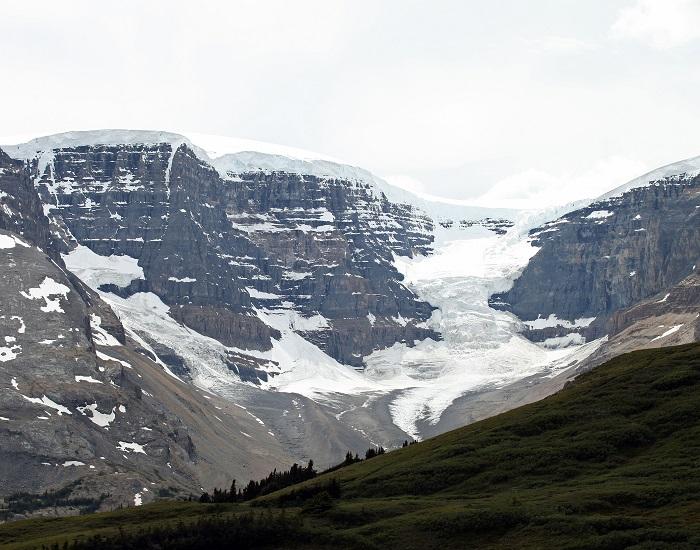
The hike to Wilcox Pass offers views of Snow Dome and Dome Glacier/Scott Johnson
Wilcox Pass
Inspired by the scenery but tired of the crowds at the Discovery Centre, we drove a couple miles further to the trailhead for Wilcox Pass, which starts at Wilcox Campground. We wanted to get up into the mountains, and Wilcox Pass came highly recommended in a couple guidebooks. The 5-mile out-and-back follows the route of late 19th century explorer Walter Wilcox, who had to find a way around Athabasca Glacier, which at the time covered the valley where the Icefields Parkway was later built. His party returned to the valley near Tangle Falls, and a through hike leads there. Without a shuttle, though, we planned to reach the pass and turn around there.
Setting out, we weaved through forest at a steady incline, though parts of the trail were worn down to the point that we were hiking less on dirt than tree roots and rocks. Ankles, beware, particularly on the descent. Before long, the trees (and their roots) receded, and views opened up. At our feet, yellow, red, purple, and orange flowers sprung from a small meadow. In the distance, the mountains and glaciers of the Columbia Icefield filled the skyline. We had a commanding perspective of mounts Andromeda, Athabasca, Snow Dome, and Kitchener framing Athabasca and Dome glaciers. A triangle-shaped forest between the two rivers of ice is home to 700-year-old trees, some of the oldest in the park.
A couple of Parks Canada’s famous red chairs, placed at strategic locations for visitors to slow down and take in the scene, pointed toward the same mountain vista found at the Discovery Centre, only we had it to ourselves. If your only goal is sweeping mountain views (and there’s nothing wrong with that), this is probably the best spot to stop and head back.
We decided to keep going, and a returning group told us that a herd of bighorn sheep were up ahead. This inspired us as a chill rolled in and clouds blotted out the sun. We passed Wilcox Creek and its small valley and reached a post that signified that we had made it to the pass, yet we still hadn’t seen any sheep. At this point, the temperature had dropped significantly and it was later in the day than I’d planned, so we headed down a little disappointed but ready to get out of the wind. Turns out, we had been looking the wrong direction. Heading back, we almost immediately spotted tiny specks of sheep to our right, in front of the mountain backdrop.
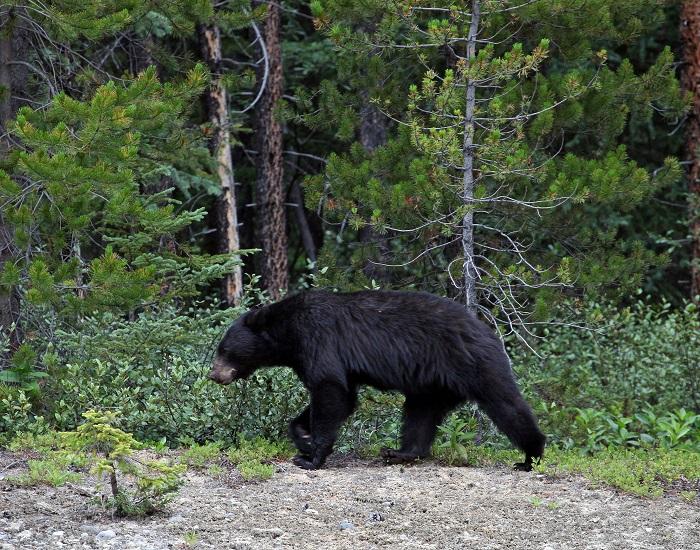
This black bear was walking along a ridge just above the Icefields Parkway/Scott Johnson
Exiting Jasper
Just south of Wilcox Pass, you cross the boundary from Jasper to Banff at Sunwapta Pass, the second-highest point along the parkway. Unfortunately, we were going to be late for an appointment at our guesthouse for the night, and the weather had fully turned.
Aside from pulling over for a couple minutes to take photos of a black bear on the ridge across the road, we unfortunately had to zoom forward, past Parker Ridge, Weeping Wall, Saskatchewan Crossing, Peyto Lake, Bow Lake, Crowfoot Glacier, and so much more. I don’t need an excuse to return, but I feel like we missed out by not seeing these special places. But there are only so many hours in a day, and we had to get to Field, home base for our stay in Yoho National Park.



Add comment